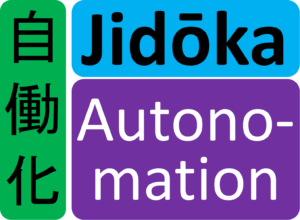 In my last post I explained what jidoka is (at least in my view). The key part is to stop the line for any irregularity, and resolve the problem. Also try to make sure this irregularity does not happen again. However, this definition is far from universally accepted, and there are many different opinions. Here I will try to show the philosophical idea behind Jidoka as one of the two pillars of the Toyota Production System (the other is JIT).
In my last post I explained what jidoka is (at least in my view). The key part is to stop the line for any irregularity, and resolve the problem. Also try to make sure this irregularity does not happen again. However, this definition is far from universally accepted, and there are many different opinions. Here I will try to show the philosophical idea behind Jidoka as one of the two pillars of the Toyota Production System (the other is JIT).
A Lot of Different Meanings …
 Part of this variety of names may be due to the many different meanings that have been attached to jidoka. The source of the list below is the highly recommended book Working with Machines by Michel Baudin.
Part of this variety of names may be due to the many different meanings that have been attached to jidoka. The source of the list below is the highly recommended book Working with Machines by Michel Baudin.
- At Toyota, jidoka is seen as the ability to stop a machine or process if there are any problems. This applies to manual or automatic processes, and these problems may be for example a breakdown or quality issues.
- Jidoka may also refer to semi-automated machines, where a worker can manage multiple machines at the same time, for example in a chaku chaku line.
- Some use the original translation and see jidoka as automation, where there is a gradual increase in automation over time, and hence people do less and less manual work.
- Another definition, confusingly also from Toyota, sees jidoka as the automation of dangerous, dirty, or demanding work (also known as 3K for kiken (危険, dangerous), kitsui (きつい, difficult), and kitanai (汚い, dirty)).
As you see, it is all very confusing. Different definitions exist even within Toyota. Which one should it be? All of them involve humans and automation in some aspects. Of course, I have no authority to set the ultimate definition, but I do have an opinion.
The Toyota House

We often like to arrange a set of methods in a methodology in the shape of a house, with a basement, pillars, and a roof. There is also a house for lean manufacturing, called the House of Toyota. While there is no commonly agreed-on House of Toyota, jidoka is commonly seen as one of the two pillars of the Toyota Production System. The other pillar is Just in Time. As for the bottom and the top, there is little agreement beyond stuffing the bottom with lean tools and philosophies and the top with positive outcomes. Hence I left these out from this (simplified) house shown here.
Just in Time is all about flow. Parts should arrive just when they are needed, in the amount needed, and in good quality. After processing, the parts continue to arrive just in time downstream at the next processes. If you have JIT everywhere, your parts would be flowing all the time, except for brief stops for processing. Hence, this “flow” is clearly one of the significant underlying philosophies at Toyota.
Now, as for jidoka, which definition could we use to complement this idea of flow? Eliminating dirty, dangerous, and demanding work (#4 from above) is clearly too mundane, as is multi-machine-handling (#2) and some bit of automation (#3).
However, the idea to stop a process if there are any problems (#1) and then make sure that it does not happen again is a very important concept for me. This overlaps a bit with multi-machine-handling (#2) and automation (#3).
Hence, JIT is the goal to establish flow, and jidoka means a process stops automatically if there are any irregularities.
A Bit of Philosophy
 Diving deep into the Toyota philosophy, you could see this as JIT telling you to let the material flow, and jidoka telling you when to stop the flow. This is a bit like the Chinese philosophical concept of Ying and Yang, where seemingly opposite or contrary forces may actually be complementary.
Diving deep into the Toyota philosophy, you could see this as JIT telling you to let the material flow, and jidoka telling you when to stop the flow. This is a bit like the Chinese philosophical concept of Ying and Yang, where seemingly opposite or contrary forces may actually be complementary.
The same applies here. JIT encourages flow, and Jidoka encourages stops, which seems contrary. However, both help to produce more and better parts at a lower cost. Unfortunately, JIT gets much, much more attention as it is the glamorous and positive side, whereas jidoka is often seen as all about problems and stops and other negative aspects. Yet, both are necessary for a good production system.
Comparison: GM vs. Toyota
 As a counter-example, let’s take the old Fremont plant of GM (closed in 1982, and later reopened as the Toyota-GM joint venture NUMMI). In Fremont, the philosophy was to never ever stop the assembly line, no matter what. When there were quality problems, they were merely pushed down the line, creating massive problems downstream. Occasionally this even resulted in zombie cars that were half of one model and another half of a different model. Needless to say, the repair and defect costs were enormous. They also did not stop for lack of manpower, and simply hired some people from the bar across the street on the spot and put them on the line – again with devastating results for quality. There are even reports of accidents and injuries where the line was kept running. Yet, despite the “keep it running” vision, the line was stopped frequently. (GM has since then improved, but the idea to keep the line running is still strong).
As a counter-example, let’s take the old Fremont plant of GM (closed in 1982, and later reopened as the Toyota-GM joint venture NUMMI). In Fremont, the philosophy was to never ever stop the assembly line, no matter what. When there were quality problems, they were merely pushed down the line, creating massive problems downstream. Occasionally this even resulted in zombie cars that were half of one model and another half of a different model. Needless to say, the repair and defect costs were enormous. They also did not stop for lack of manpower, and simply hired some people from the bar across the street on the spot and put them on the line – again with devastating results for quality. There are even reports of accidents and injuries where the line was kept running. Yet, despite the “keep it running” vision, the line was stopped frequently. (GM has since then improved, but the idea to keep the line running is still strong).
Toyota, on the other hand, stops the line whenever there are problems, and then tries to find a solution. As a result, newly created assembly lines at Toyota stop very often but, after a few months’ ramp-up, run much, much more reliably than other automakers’ assembly lines. This results in better quality and less expenses.
A Practical View
Jidoka works very well because Toyota provides a LOT of manpower to resolve such issues, and you would be flabbergasted to hear how many people a Toyota plant has to help with such problems.
 Quite possibly, your plant may not have such a luxury of excess manpower to solve problems. Any excess manpower may have long ago been removed to cut cost. Yes, you probably still have a qualified problem solver, someone to take care of problems. However, that person is probably also responsible for managing 200 people, creating their schedules, taking care of absences, resolving employee disputes, doing data entry into a computer, following up on missing parts, adjusting the production schedule based on changing customer demands, and making sure that the toilets still work, all besides being the first responder for 100+ machines and gazillions of quality problems.
Quite possibly, your plant may not have such a luxury of excess manpower to solve problems. Any excess manpower may have long ago been removed to cut cost. Yes, you probably still have a qualified problem solver, someone to take care of problems. However, that person is probably also responsible for managing 200 people, creating their schedules, taking care of absences, resolving employee disputes, doing data entry into a computer, following up on missing parts, adjusting the production schedule based on changing customer demands, and making sure that the toilets still work, all besides being the first responder for 100+ machines and gazillions of quality problems.
The point I want to get to is that your highly qualified problem solver simply has no time to solve problems, and because he is so qualified, he is so overloaded that he can barely keep the plant going.
Jidoka is the automatic machine stop in case of abnormalities. Someone has to take care of the problem, and at least add a temporary fix. Not applying a quick fix to get the machine running again will obviously be a problem, because then you produce no more parts. Not stopping the machine in the first place will be even worse, because you create many more issues downstream, eating up even more of the time of your people.

An optional logical next step is to find the root cause to eliminate the problem for good. However, your people may not have the capacity for a long-term fix. Purists will disagree with me, but you may have to do with a quick fix. Yes, the problem will pop up again, and will continue to eat up more manpower. But in this situation you are like a poor person who cannot afford a good car, and the junk he is driving will cost him more in repairs and delays than if he would have bought a better car. Telling the poor guy to just spend more money on a better car does not help here.
Still, try to put in some effort to get at least the worst issues resolved permanently. Out of the many reasons for the stops of the process, prioritize and pick one problem that you want to work on. Try to get this fixed. Once this is done, work on the next problem. Repeat and keep on going until … well … sorry … this will continue as long as you are in this position, and your successor will have to continue after that. Problems in a factory have a tendency to never end.
Also, even Toyota cannot fix all their problems. One key element of jidoka is that if you cannot prevent the mistake, then at least the machine should stop so you can fix it. This automatic stop is also already big step in the right direction.
Summary
Usually my blog posts are much more into practical advice, but I hope you still enjoyed this excursion into the Toyota philosophy of jidoka and JIT. Or maybe my head is just turning mushy from the heat. In any case, my next post on Jidoka will have some examples. Anyway, now go out, and organize your industry!
P.S.: This series of blog posts started because Sammy Obara at the very nice Lean Poland Conference mentioned that there is very little information on jidoka available online. Well, challenge accepted 🙂

that´s the common mistake I have seen, they do not want to stop the line. As you say, We do not realize the chance that we lose to understand the problem when is active or fresh and work hard that to solve it.
Very clear, thank you Christopher. It might be useful to mention that in Toyota they do strive to keep the line going too and fix minor problems within the takt with the aid of a supervisor or water spider. The role and skills of the water spider might make an interesting post. Best wishes, Eoin
Hello Eoin, good point. Toyota has very small teams of 4 people plus one team leader. The team leader’s job is to help so things get fixed within the takt. If an automotive assembly line stops, 200 people may be waiting on one station. That gets expensive fast.